Phnom Penh Travel Guide: What you need to know before you go
Cambodia’s capital and largest city – Phnom Penh can easily fill any traveler’s schedule for a couple of days.
The city is not spectacular but it has its attractions: A nice and pleasant walk in front of the huge Tonle Sap River, several interesting temples, lots of markets, good food at a good price and some historical places from the recent era of the Khmer Rouge that will leave you without encouragement and will give anyone who wants to take a little interest in them to reflect.
Phnom Penh History
Phnom Penh takes its name from the hill temple “Wat Phnom Daun Penh” which was built on an artificial hill in 1372 to accommodate Buddha statues. Translated, the name means something like “Hill of Penh”.
Cambodia has had several capitals in its history including Angkor, of course, then Longvek and Udong until finally, King Norodom moved his seat of government to Phnom Penh in 1866 – at the urging of the French colonial administration, which wanted to set up its administrative seat there.
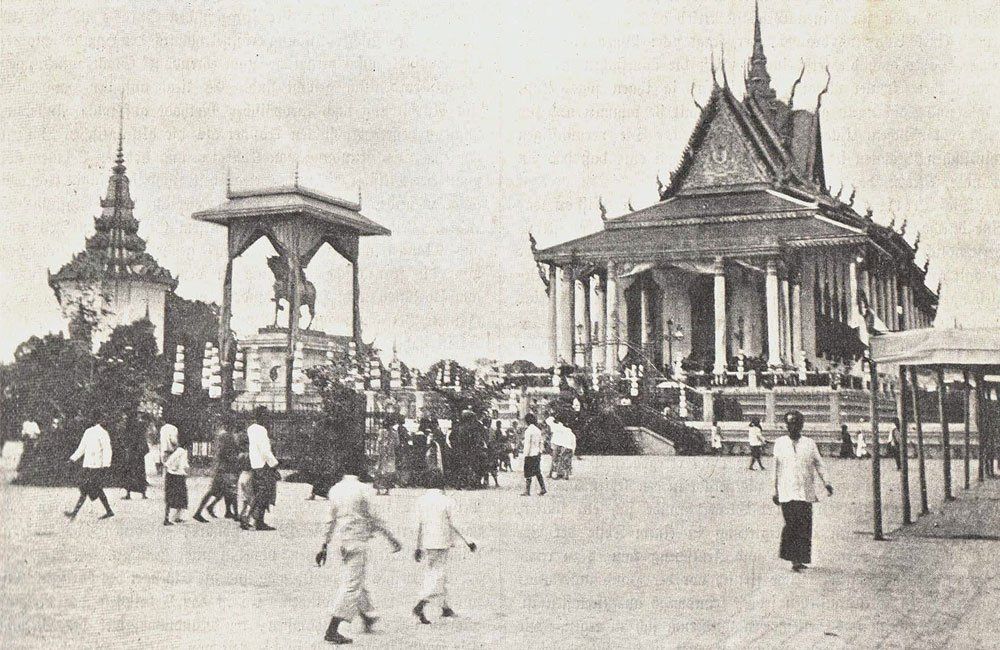
The French, who were a bit further back then in terms of urban development, rebuilt the city according to their taste until Cambodia proclaimed its independence in 1953 and they had to leave again. The French colonial style has shaped the cityscape very much.
Dark years followed. After the Indochina War raged and countless peasant families fled to Phnom Penh due to the heavy bombing by the US Air Force, the capital was conquered by the Khmer Rouge on April 17, 1975.
This started the darkest chapter in Cambodia’s history. The Khmer Rouge, led by Pol Pot pursued the idea of a self-sufficient peasant state that included the expulsion of the population from the city and resulted in a genocide. So while Phnom Penh was the residence of the elites and high-ranking politicians, a large part of the population was disenfranchised, expropriated and used for forced labor in the countryside or prisons. As a result, two million people are estimated to have died from starvation, disease and execution.
In 1979 the Khmer Rouge were driven out by Vietnamese troops but shattered Cambodia did not calm down for a long time. There were unrest and civil war well into the 1990s, and from 1992 to 1993 Cambodia was even placed under the supervision of the UN (United Nations). The first free elections were held in 1998 and the first criminal tribunals against the officials of the Khmer Rouge started in 2005. Since then, Phnom Penh has slowly recovered and it is now a comparatively modern city and the interesting center of the Kingdom of Cambodia.
Phnom Penh City and Orientation
Phnom Penh is located in the south of Cambodia, directly on the Tonle Sap River and the tributary of the Mekong. Phnom Penh International Airport is 10 kilometers west of the city center.
There are no real parts of the city, one rather orientates oneself on cardinal points. In the north of Phnom Penh, for example, is the district around Boeung Kak, which was once considered a backpacker district, but is also in a state of change.
In the south, from 360th Street, there is the Russian market. There are residential and industrial areas in the west and east of the city, and an enormous amount is being built and developed here. Most interesting for travelers is the center and the riverfront. Most of the hotels, bars, restaurants, and many sights are located here. As the city center, the Central Markt is a good reference point for excursions.
What to do and see in Phnom Penh
Phnom Penh offers a wide range of sights and activities. Some of the oppressive and some of them pure pleasure. Studying the history of Cambodia while in the capital is something that every traveler can only recommend.
Related post: 9 Things to do in Phnom Penh
1. Royal Palace and Silver Pagoda
The Royal Palace in Phnom Penh has been the king’s residence again since the late 1930s. The palace grounds are partly open to visitors, only the part where the king actually lives is closed. Part of the visit is the Silver Pagoda, built-in 1962 which houses a large emerald Buddha and many art treasures. Photography and filming are allowed everywhere except in the Silver Pagoda and in the throne room, but costs extra – the entrance fee including the camera is around 8 dollars. You can reach the Royal Palace and the Silver Pagoda via 240th Street, which is near the riverfront and therefore very centrally located.
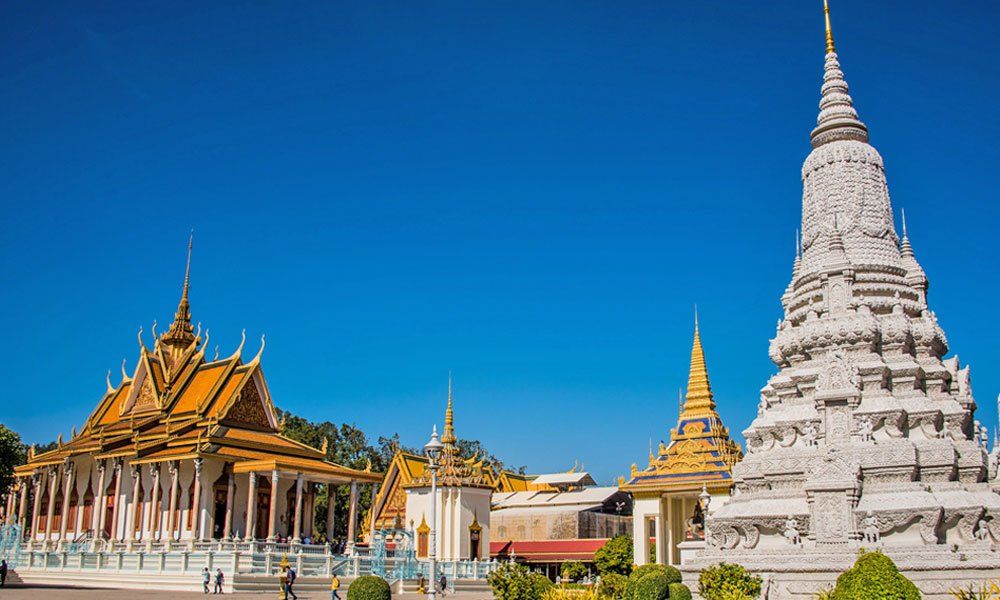
2. Choeung Ek (Killing Fields)
Choeung Ek is the most famous of the many killing fields in Cambodia, and it is definitely one of the most depressing places to visit. Killings Fields were those execution sites (and mass cemeteries) where the Khmer Rouge of their time murdered people they considered annoying or useless. In Choeung Ek alone, which was the execution site of the S-21 prison, around 17,000 men, women and children were victims of the regime.
Today the area looks very idyllic, like a garden by a lake, but visiting the mass graves and the adjoining museum makes it impossible to be captured by this idyll. There aren’t a lot of words to say about it, and it’s just as terrible as it sounds. But a visit to the Killing Fields will help you understand the country and its history.

3. Toul Sleng Genocide Museum
The visit to the former S-21 prison, which usually follows, is no less depressing. Preserved as a museum, it is now intended to commemorate the victims of torture and murder under the Khmer Rouge and remain a memorial. People were tortured in the prison in order to get information or confessions from them – including opponents of the regime, teachers, doctors, intellectuals, students, and their families. The building served as a high school before the Khmer Rouge and accordingly consists of several multi-story blocks with individual rooms and an inner courtyard. As a visitor, you can walk through the rooms independently and look at exhibits, memorial plaques, and pictures. The museum is now part of the UNESCO World Document Heritage. It is almost in the city center and can therefore be reached quickly.
Related post: The 7 Reasons to visit Cambodia

4. Wat Phnom
You will also find an older relic of the city’s history in the center of the riverfront: Wat Phnom. Legend has it that a certain woman Penh, who was immortalized here like a statue, found four Buddha statues in the Mekong in 1372 and raised the hill (Phnom) in their honor, and built the temple. The city name was born with the hill Penh. Today the temple can be visited every day for a dollar admission fee.

5. National Museum
The ornate red sandstone building, in which the National Museum of Cambodia is located, houses around 5,000 exhibits, including, for example, ancient artifacts from the Angkor era and the post-Angkor era as well as archaeological finds. The museum is located directly at the Royal Palace and is open daily from 8 am to 5 pm and no photography is allowed.
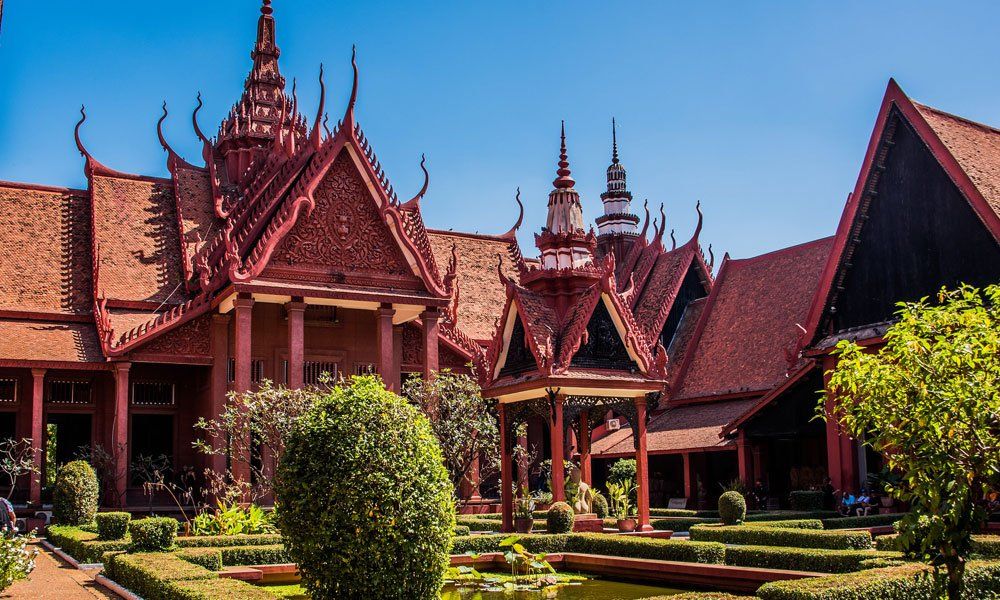
6. Eat & Drink in Phnom Penh
Phnom Penh offers Asian dishes of all stripes such as curries, fried foods as well as noodles, meat, and rice dishes. The cuisine of Cambodia is a hybrid of the French colonial past and the influence of neighboring Asian countries.
You don’t have to go hungry in the capital, you have a free choice from gourmet restaurants to simple cookshops. Menus are mostly written in English and at least have colorful illustrations. Most of the restaurants can be found around the markets, as well as on Sisowath Quai, the street on the Mekong bank.
In addition to the sometimes very touristy restaurants in the street, there is still something to discover along the promenade. Flying vendors and food stalls offer their goods and meals, and you can often find specific local specialties here: fried or grilled insects, worms, tarantulas, and snakes. Some believe that snakes and spiders were only eaten in Cambodia since the famine of the Khmer Rouge. The locals say, however, that this is part of history and has always been practiced. You don’t really know, but the fact is that there are hardly any taboos in Cambodian cuisine.
Related tour: Cambodia Real Food Adventure
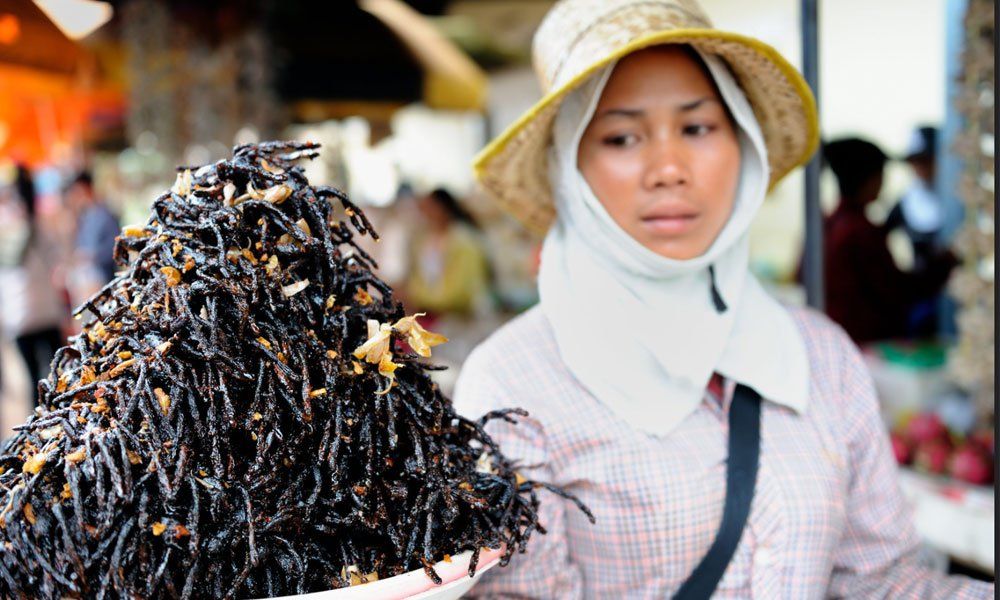
Just take a photo of the insect stand and then move on, because the sellers can’t live on it – so they usually take a dollar for a photo if you don’t want to buy anything else from them.
If you can switch off your culturally trained disgust and are not a vegetarian, you should have a small tasting portion made for you. For preparation, the insects are rubbed with spices, dusted with flour, and then deep-fried in hot oil – this means that they usually have no taste of their own and taste at most like the spice with which they were prepared. The consistency can, however, be quite unusual, because the legs of some animals can prick in the mouth.
The all-clear for those who are not constantly looking for culinary challenges: In addition to frogs and insects, there are also many international restaurants and fast-food chains in Phnom Penh – if you just want a pizza. Food and drink are generally really cheap here, at cookshops you pay one to three dollars per dish, in restaurants a little more. But overall the price level is very low.
Related post: Top 5 Breakfasts in Cambodia

7. Nightlife in Phnom Penh
Today you will find the liveliest and most exciting nightlife in the capital of Cambodia. Half of the city meets at the riverside in the evening. Are you looking for a party? There are some nightclubs here where expats and tourists in particular cavort. Bands perform in the Sharky Bar every weekend.
If you want to experience a beautiful sunset of the city from above, then try the Rooftop Bar Chow in the Quay Hotel, the Eclipse Sky Bar, or the Cloud 9. Phnom Penh does not have a particularly exciting skyline you have to say that. Nevertheless, of course, you have everything in view from here.
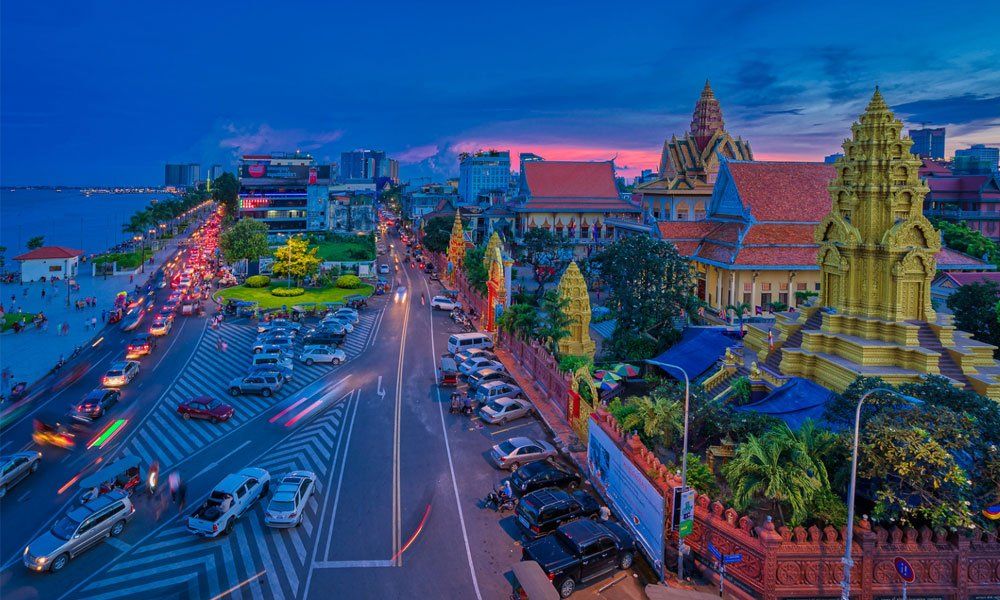
8. Shopping in Phnom Penh
Countless department stores and markets also make extensive shopping tours possible. The Russian Market is an absolute must, here you can really hunt bargains. Mainly there are souvenirs, handicrafts, and textiles to buy. You can also get spices such as the famous Kampot pepper at a cheaper price.
The most famous and beautiful market is the Phsar Thmey, the Central Market. The large building with the Art Deco style dome was built in 1935 and offers shoes, jewelry, watches, DVDs, electronic items, and much more. Here you will find a large selection and everything is very clean and well-kept.
Just around the corner is the Sorya Mall with eight floors of fashion stores, supermarkets, and restaurants. North of the city center on the riverside, there is also the Old Market (Phsar Chas) which is more tranquil and more popular with locals.
The hustle and bustle of the market begin everywhere in the early morning when the traders set up their wares and the residents of Phnom Penh go shopping. At lunchtime, it is rather quiet. In the late afternoon, the action increases with tourists, hawkers, and food stalls.
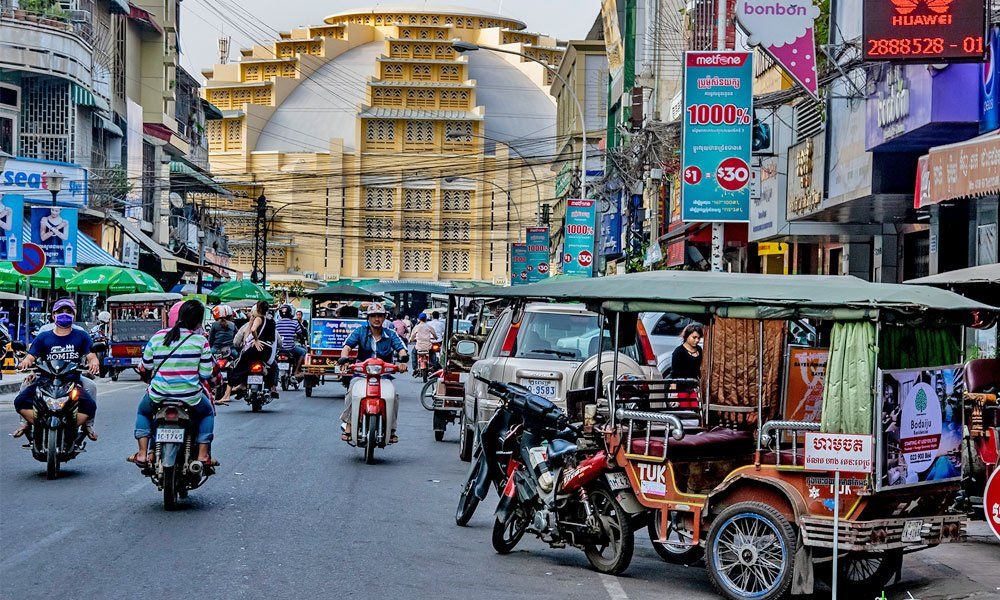
9. ATM / Withdraw money in Phnom Penh
Finding ATMs in Cambodia’s capital is no problem at all. They are everywhere, usually work, and accept all major cards. Large banks are, for example, ABA Bank, Canadia Bank, Cathay United Bank, Cambodia Public Bank, and ANZ Royal Bank. Money is issued with foreign cards in dollars, as a tourist, you only get the Cambodian riel as change.
Transaction fees for withdrawals are due in any case ($4-$6), plus the fee of the house bank can be added. You can save money if you have a good travel credit card for Cambodia that allows you to withdraw money abroad free of charge.
Paying directly by credit card is becoming more and more fashionable in Phnom Penh, even though it is currently more accepted in hotels and international shops, and restaurants. It can be an advantage to let your house bank know in advance that you are in Cambodia so that the card is not blocked due to unusual activities.
Travel Articles
Read the local stories, and get travel advice from our Travel Specialist. We have lived through our experience and wanted to bring first hands-on exploration through the local insider.
